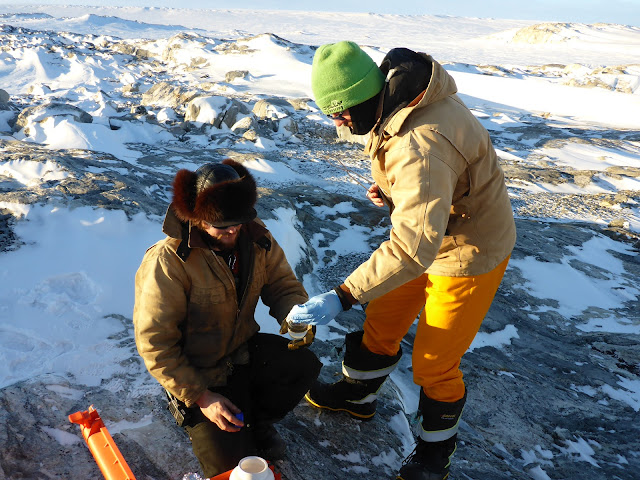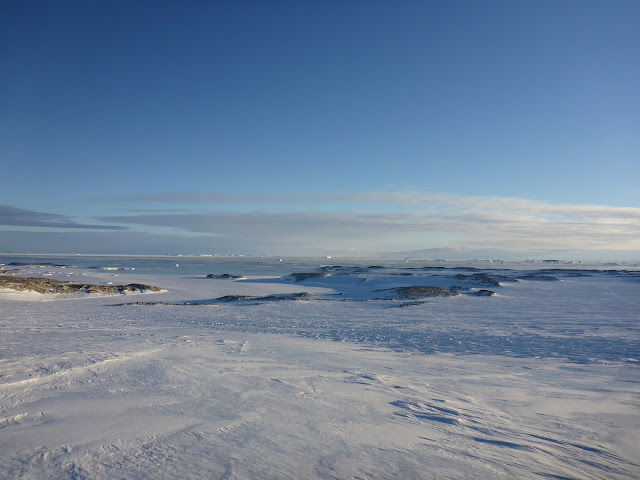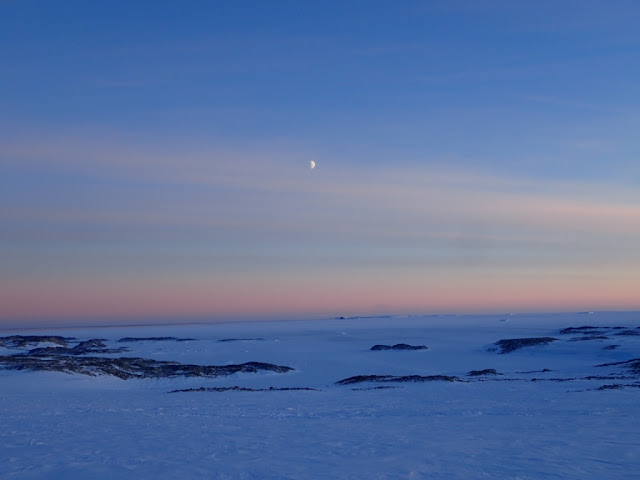One Friday afternoon, a few weeks ago, a crew of us headed out to Jack's Hut - Clint, Adam, Muscles (Steve), and I. We set off at around 3 pm into a beatiful sunset and our progress to the hut was hampered by endless calls to stop the Hagg to take photos. Adam was at the wheel, with Clint as co-pilot, and Muscles and I piled in the back .
We arrived at the hut and after Muscles got the heater going and we dropped our box of food and drinks, and backpacks inside and we went exploring. There is an old crane cab on the site off to the side of the hut which is now know as the toilet with the best view in Antarctica... well it does fill up with snow, but it has a great view out to sea. After digging out the toilet (i.e. the crane cab) we headed inside for a night of delicous food, drinks and many laughs. We had to get back to Station for 10 am for Adam to do his Slushy shift, and so the stay itself was short-lived.
A week or so later, I was digging through the filing cabinet in my Station Leader office, and came across some interesting correspondence addressed to Alison Deans the SL in 2014.
It was from a man by the name of Jack Field. This was Jack! of Jack's Donga fame!
Below is an extract from Jack in his letter to Ali, about how the hut was set up. What is now the toilet, was originally the entire hut.
These days we have a 4 bunk hut off to cook and sleep in and only use the original Jack's Donga for well, the bathroom!
"
I am the "Jack"
after whom Jack's donga is named.
We have noticed quite a few variations in the story of how the donga came to be, so you may all be interested to hear it from the horse's mouth.
I was the cook at Wilkes in 1962, and while that was a nice warm situation, I also enjoyed getting out and about as much as possible. Two of us used to hike along the sea-ice and up to the ridge where the donga is located for a day's outing. We occasionally took a dogsled and stayed overnight on the ridge in a two man tent, including one memorable time when we had trouble sleeping because of the groaning noises all around us. Early next morning, I pulled one of the tent pegs out and discovered it left a hole that went all the way down to nowhere!
Eventually it occurred to me to ask our dieso Gringo (Nev Collins) if we could use the abandoned D4 cabin as a hut. After some minor mishaps (pictures attached) it was duly transported and installed by him.
Our only mod cons in those days were two single bunks, one above the other, with the lower one being used as a seat when the upper one was folded up.
It's great to see how the site has continued to give pleasure to so many over the years, especially with the new and improved accommodation. However, it's also great to see the original cab still giving splendid service as the world's best "loo with a view"."
 |
| Jac checking out Jack's Donga. Photo: Adam Roberts |
 |
| The Jack's trip Crew. (L-R) Adam, Jac, Muscles and Clint. Photo: Ducky |
 |
| The Hagg crew. Photo: Jacque Comery |
 |
| Another sunset photo stop. Photo: Jacque Comery |
 |
| Sunset through the icy Hagg window. Photo: Steve Middleton |
 |
| Jacks Donga. Photo: Jacque Comery |
 |
| Jack Field , 1962 ANARE Chef, after who the donga is named. Photo: Unknown |
 |
| Towing the donga to site. Photo: Unknown |
 |
| A few mishaps along the way. Photo: Unknown |
 |
| The (frozen) loo with a view. Photo: Jacque Comery |
 |
| The donga as it stands today. Photo: Jacque Comery |
 |
| Geology at Jacks'. Photo: Jacque Comery |
 |
| The view out to sea, over the forming sea ice. Photo: Jacque Comery |
 |
| More fascinating geology. Photo: Jacque Comery |
























































